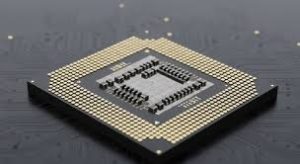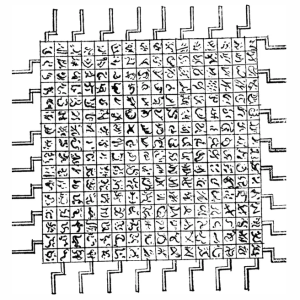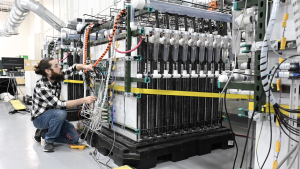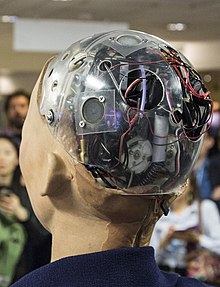“The Forever Battery”

Chinese scientists have built a nuclear battery that can produce power for up to 50 years without being recharged. (Image credit: BetaVolt)
By Scott Hamilton
I am always reading about new technologies and the one that caught my eye this week was about a new battery, invented by researchers at Betavolt, with claims it will last more than 50 years. In a recent press release the company announced, “Betavolt atomic energy batteries can meet the needs of long-lasting power supply in multiple scenarios, such as aerospace, AI equipment, medical equipment, microprocessors, advanced sensors, small drones and micro-robots.” The Beijing based company is the first in the world to miniaturize atomic energy, placing nickel-63 isotopes into a module smaller than a coin.
So exactly how does a nuclear battery work? In the case of Betavolt’s atomic battery it works by converting the energy released by the decaying isotopes into electricity, through a fairly old process first explored in the 20th century. Scientists in the United States and the Soviet Union were developing this same technology for use in spacecraft, underwater systems and remote scientific stations for several years, but the thermonuclear batteries they designed were both costly and bulky.
A thermonuclear battery takes the heat generated by the decay of certain isotopes and converts the heat to electrical currents. The early thermonuclear batteries were utilizing isotopes which released hazardous radiation and as a result required thick, lead-lined containment to protect the user and environment from the negative impacts of the radiation. One of the key differences in Betavolt’s technology is the use of low radiation isotopes, which greatly reduces the risk of radiation exposure, resulting in the ability to produce their batteries in a much smaller form factor.
The older thermonuclear batteries used in such devices as the Voyager spacecraft, the Mars Rover, and several other space projects, weigh in between 30 and 100 kilograms and range in size from about the size of a mini-fridge to the size of a small car. A majority of their older batteries utilized small quantities of plutonium as the core energy source, and surprisingly as early as the 1970s, we were manufacturing small plutonium cells for use in implanted heart pacemakers to ensure a very long “battery life.” They were in very limited use – 100-150 were implanted in the early years. In 2004 around 90 of these pacemaker batteries were still in use and by the end of 2007 only nine were still operational. The implant program started in June 1966 and was ended in 1972 when it was learned that the cells could be destroyed during cremation, exposing the nuclear radiation, and there was no way to ensure the pacemakers would not be cremated with their users’ bodies.
In the very simplest designs a thermocouple, which is literally just two different metals brought in close contact, creates electricity when a heat difference is placed between the two metals. The larger the heat difference, the more electricity is generated. The one side of the thermocouple is placed in the wall of a container full of radioactive material and the other side against a heat-sync, usually a large chunk of aluminum. As the radioactive material decays it produces an extreme amount of heat which results in the electric generation of the thermocouple.
Betavolt is not the only company working on the small thermonuclear batteries, but they were the first to announce a viable product as part of China’s Five-Year Plan designed to strengthen the country’s economy. The thing I found most fascinating about Betavolt’s battery was the extremely small size, coming in at only 15x15x5 cubic millimeters and producing 100 microwatts. This is enough power for small devices, and their plans to release a 1-watt model by the end of 2025 means that we could see in the near future a cell phone coming out of China that you never have to charge, with a battery life of 50 years. They are the first company to make these types of batteries small enough and safe enough to be utilized in general consumer electronics. I became really excited to learn that definitely within my lifetime we have the possibility of mobile electronics that we never have to charge. Could you imagine a cordless drill, flashlight, cordless chainsaw, etc, that you just picked up and used, without ever having to worry if you charged it after the last use.
My biggest concern is that once again it seems that we have fallen behind China and Japan when it comes to releasing new technologies. We have been working towards a similar goal and it makes me wonder if we are falling short, or if they are being secretly developed for military and government programs behind the scenes. I know several industries that have their latest product ready for mass production several years before the release. In fact it happens in the computer industry all the time.
Until next week stay safe, and don’t forget to charge your phone. Until these new batteries become readily available, I’m afraid we must all keep our ugly phone chargers around.
Scott Hamilton is an Expert in Emerging Technologies at ATOS and can be reached with questions and comments via email to shamilton@techshepherd.org or through his website at https://www.techshepherd.org.







This is truly a fascinating breakthrough in energy technology! The idea of a nuclear battery that can last for 50 years without recharging sounds like something out of science fiction. It’s impressive how Betavolt has managed to miniaturize such a complex technology into something as small as a coin. The potential applications in aerospace, AI, and medical devices could revolutionize those fields significantly. However, I’m curious about the long-term safety of these batteries, especially in consumer devices—how will radiation exposure be monitored over decades? Also, will the cost of production make it accessible for broader use, or will it remain limited to specialized industries? What are your thoughts on the ethical implications of using nuclear technology in everyday devices? Would you feel comfortable using such a battery in your phone or other personal gadgets?